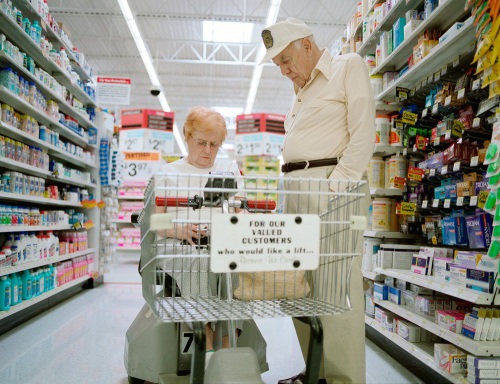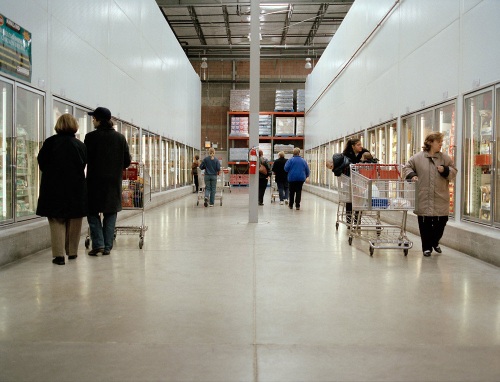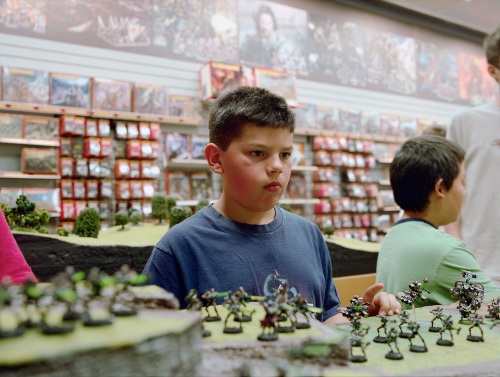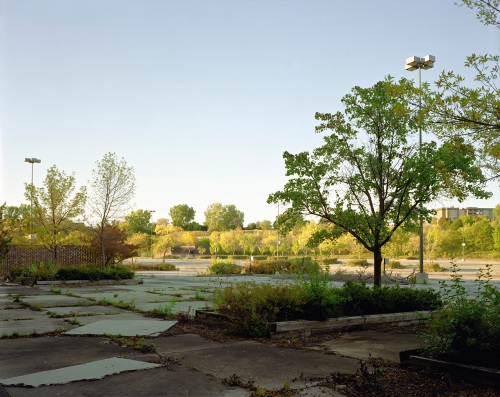
Image Credit: Brian Ulrich, Elkhart, IL 2003
Over the holidays I stumbled across Copia, a series of photos by Brian Ulrich. Throughout them he resists the packaged narratives we have for our consumerism. In both critique and support it seems that the act of shopping is pushed toward two extremes. There’s shopping as glitzy exuberance and shopping as a soul crushing slog. In Copia we can see a different perspective. He writes that the project “began as a response to the heated environment of 2001.” In the aftershock of September 11th any possible community driven healing process “was quickly outpaced as the government encouraged citizens to take to the malls to boost the U.S. economy thereby equating consumerism with patriotism.” His photographs show, more than anything else, a deadening sense of resignation. The people in his photos are grimfaced; they are doing their duty as they move through the various middleclass shopscapes. In these photographs we see shoppers as the products experience them.

Image Credit: Brian Ulrich, Chicago, IL 2003
For all the grief poured upon malls and big-box stores they are often still held up as great places to people watch. Go to the mall and see the suburban dad in his natural habitat. These photos, though, don’t imagine people seeing people; the lens is not a stand in for our eyes. And one of the most intruiging aspects of Ulrich’s work is that more these photos actively work against a human gaze—they’re an environment’s gaze, a pillar’s gaze, a toy’s gaze. Because there’s no readymade anthropomorphic gaze that a viewer can enter into there’s no real sense of familiarity in these photos. So even though nearly any viewer has been and most probably is the people featured we cannot find a point of recognition.

Image Credit: Brian Ulrich, Gurnee, IL 2005
While it’s easy to read a certain smirk into the photographs, I think that we should resist the impulse. Ulrich, or perhaps more properly, the objects watching us aren’t mean spirited. By finding a spirit in them at all (other than mean it’s exceedingly easy to read pity into them) I think that we miss the mark. So rather than attempting an interpretation of the image we can instead, see it as an active flattening of the objects in play. The boy and the miniatures and the landscapes as objects in relation to one another.

Image Credit: Brian Ulrich, Untitled, 2006 (0621)
Copia has been an active project since 2001, and eventually Ulrich shifted from malls and big-box stores to thrift shops. And while many of these photos capture people in the same way he did before the resignation is compounded. Five years on from the project’s beginning and the heaped objects have taken on the empty burden of the shoppers. They are worn out, used up.

Image Credit: Brian Ulrich, Rose, Northridge Mall, 2010
Ulrich continues to move and nine years into the project his focus has largely shifted to the stores themselves. Amidst the busted out, weary, empty malls and supercenters is the above photograph of an abandoned mall’s parking lot. The parking lot has slowly gone to seed. The once neatly trimmed planters have overgrown, and grass and weeds have begun to poke through the concrete. With this Ulrich, rather than playing on something like a hopeful return-to-nature, instead shows the naturalness of the mall. These environments, supercenters and malls and big-box retail buildings, are inhabited by people and plants and products.





Recent comments
2 years 29 weeks ago
2 years 44 weeks ago
2 years 44 weeks ago
2 years 50 weeks ago
3 years 4 weeks ago
3 years 4 weeks ago
3 years 4 weeks ago
3 years 6 weeks ago
3 years 6 weeks ago
3 years 6 weeks ago